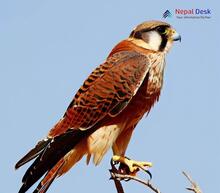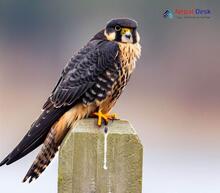Nestled between the great mountains of the Himalayas, Nepal is home to an incredible variety of bird species with over 900 recorded till now. Among these species lies a group of fascinating birds of prey - the falcons, belonging to the genus Falco. These powerful predators have captured the imagination and admiration of many ornithologists and birdwatchers across generations. Here, we'll explore the classification, common features, evolutionary relationships, and nomenclature of Nepal's falcons and discover what makes them such captivating subjects.
The Genus Falco: Classification and Common Features
Falco is a genus within the family Falconidae and holds around 38 species worldwide. Within Nepal, several species can be observed, including the Peregrine Falcon (Falco peregrinus), Saker Falcon (Falco cherrug), Eurasian hobby (Falco subbuteo), and Amur Falcon (Falco amurensis). While varying in size, coloration, and habitat preferences, all falcon species share some common features that make them unique among birds of prey.
One distinguishing feature of falcons is their remarkable speed. These birds are equipped with long, pointed wings that allow them to slice through the air at breakneck velocities. Their streamlined body shapes enhance their agile maneuverability and aerodynamics as they pursue their prey in intense aerial chases.
Another interesting characteristic is their powerful beaks, which possess sharp cutting edges called tomial teeth. These adaptations enable falcons to dispatch their prey efficiently by severing their victims' spinal cords with precision.
Evolutionary Relationships
Scientists continually strive to understand the evolutionary relationships between different species within the Falco genus. Genetic studies have provided valuable insights into these relationships by comparing DNA sequences across species.
Phylogenetic analysis indicated that the Falco genus can be divided into several clades or closely related groups. One such clade includes the Peregrine Falcons and their relatives, while another comprises lesser kestrels (Falco naumanni) and their kin. These studies have also shed light on the ancestral origins of falcons, suggesting that they initially diversified in Eurasia before radiating into Africa, America, and beyond.
Nomenclature: Naming Falcon Species
The scientific nomenclature for falcon species is based on two-part Latin names coined according to binomial nomenclature principles. The first part denotes the genus (Falco), while the second part refers to the specific epithet (species). For instance, Falco peregrinus refers to the Peregrine Falcon.
Common names for falcons usually describe some aspect of their appearance or behavior. "Peregrine" was derived from Latin "peregrinus," which translates to "wanderer" due to its wide-ranging nature. Similarly, the Amur Falcon gets its name from the Amur region in East Asia, where it breeds before embarking on a long journey to southern Africa during winter migration.
In conclusion, Nepal's diverse falcon species offer a fascinating glance into the world of these magnificent birds of prey. As we continue to uncover more about their classification, common features, evolutionary relationships, and nomenclature, our appreciation for these incredible creatures only grows deeper. So next time you're exploring Nepal's vast landscapes and beautiful natural parks, don't forget to keep an eye out for these swift hunters gracing the skies above.




